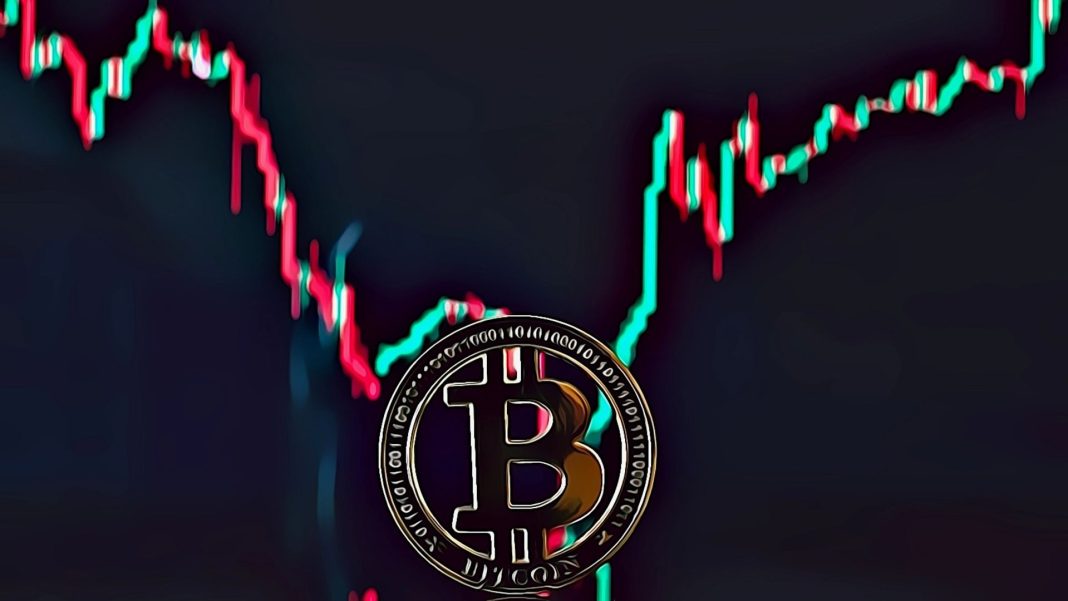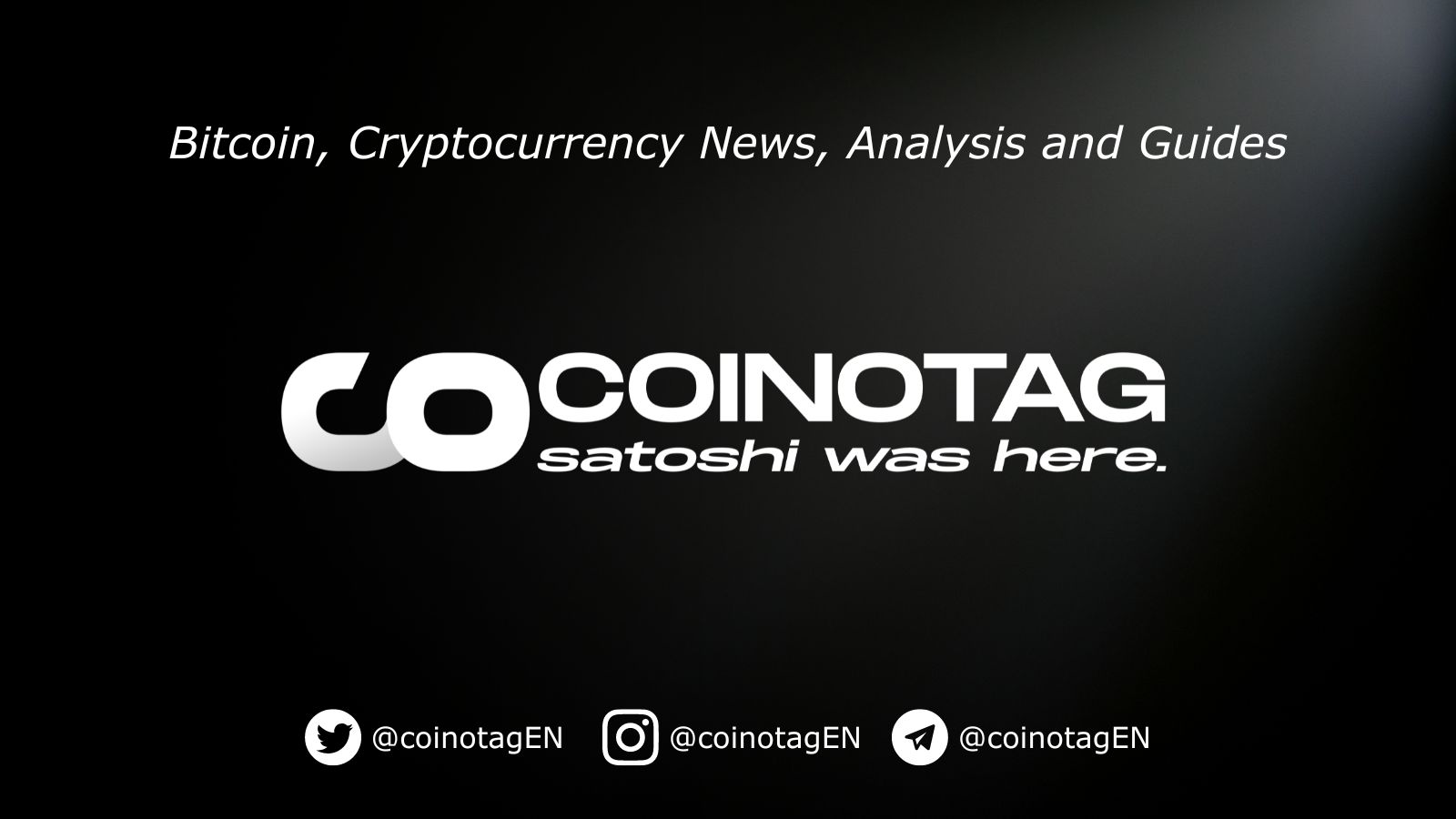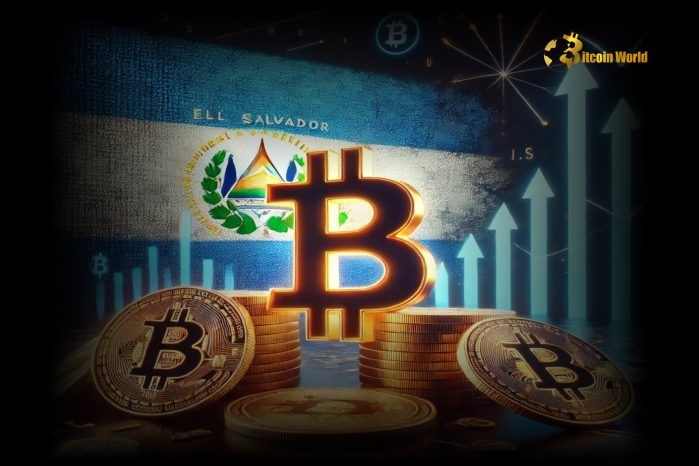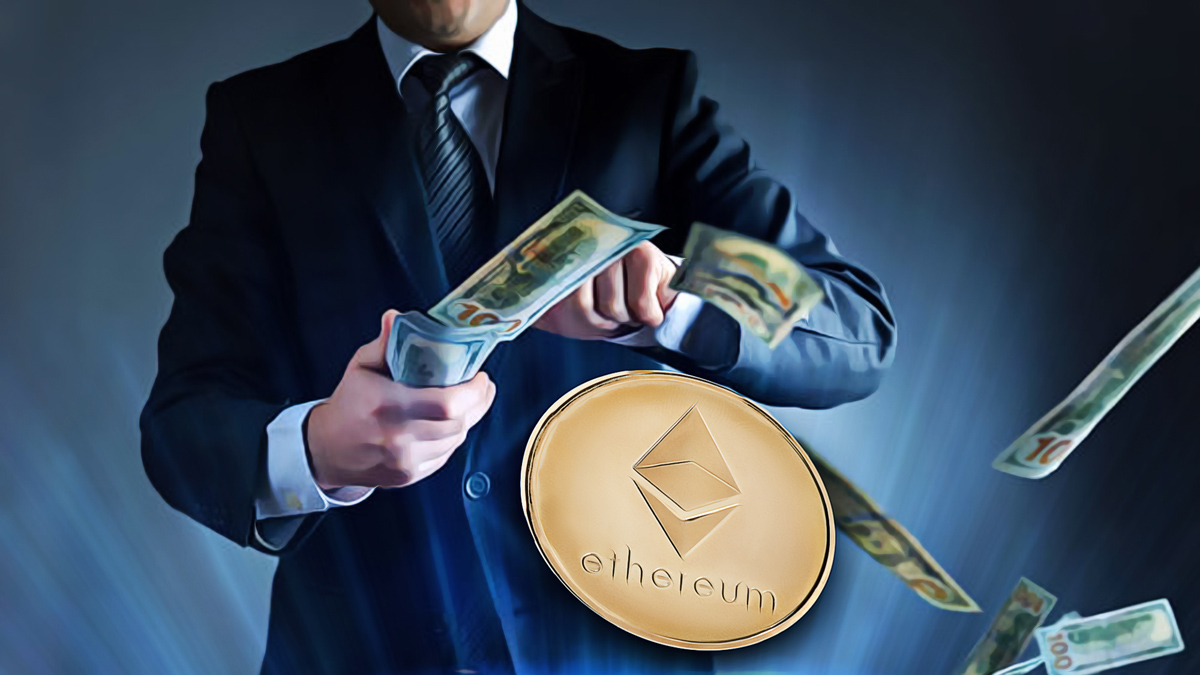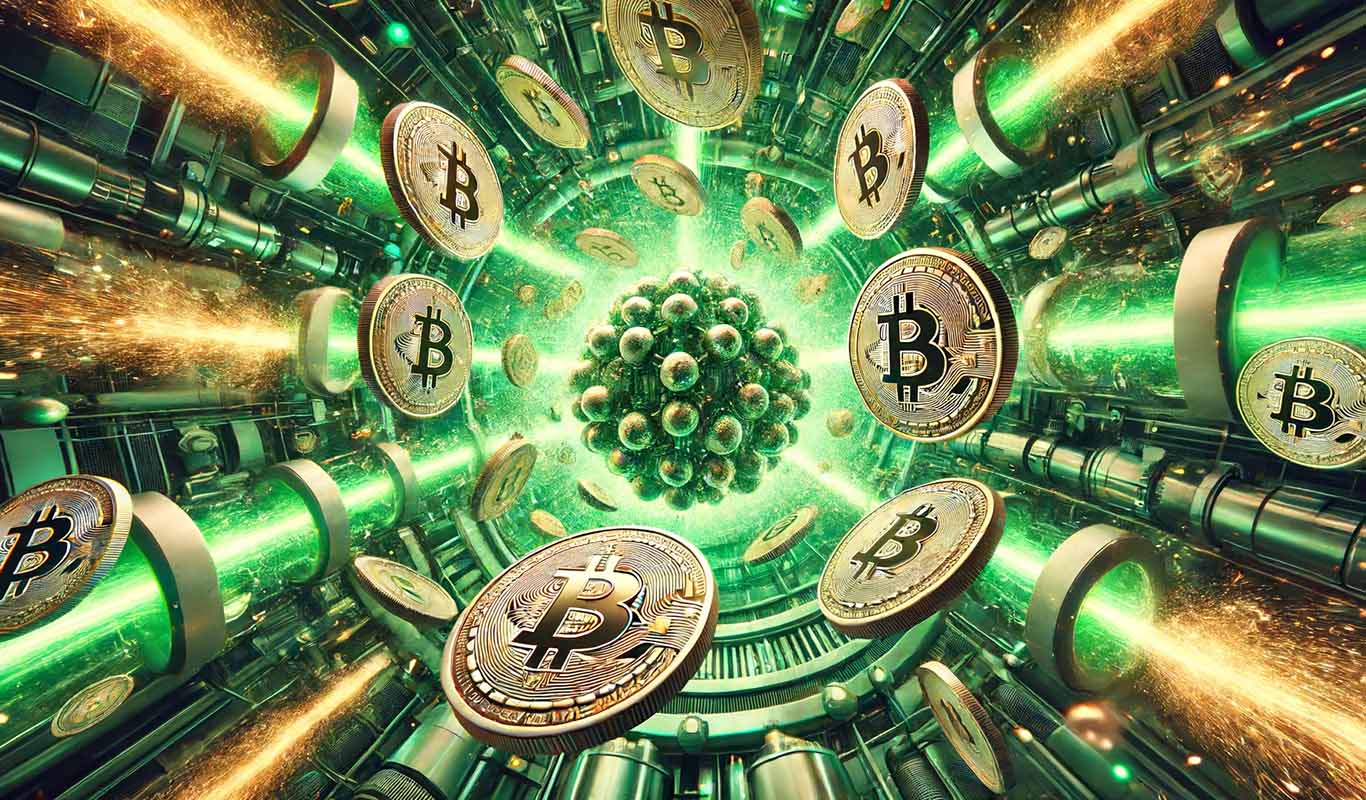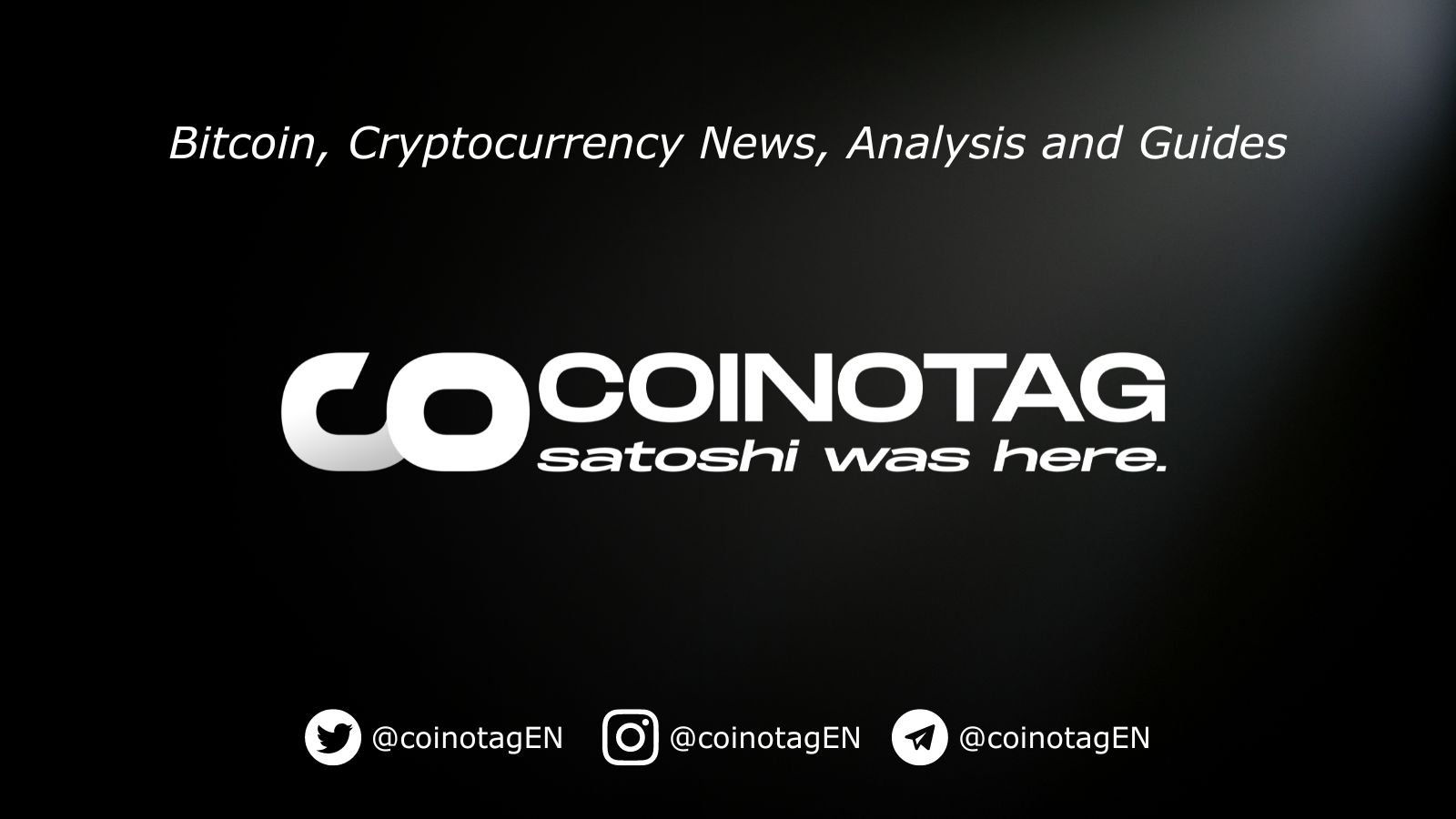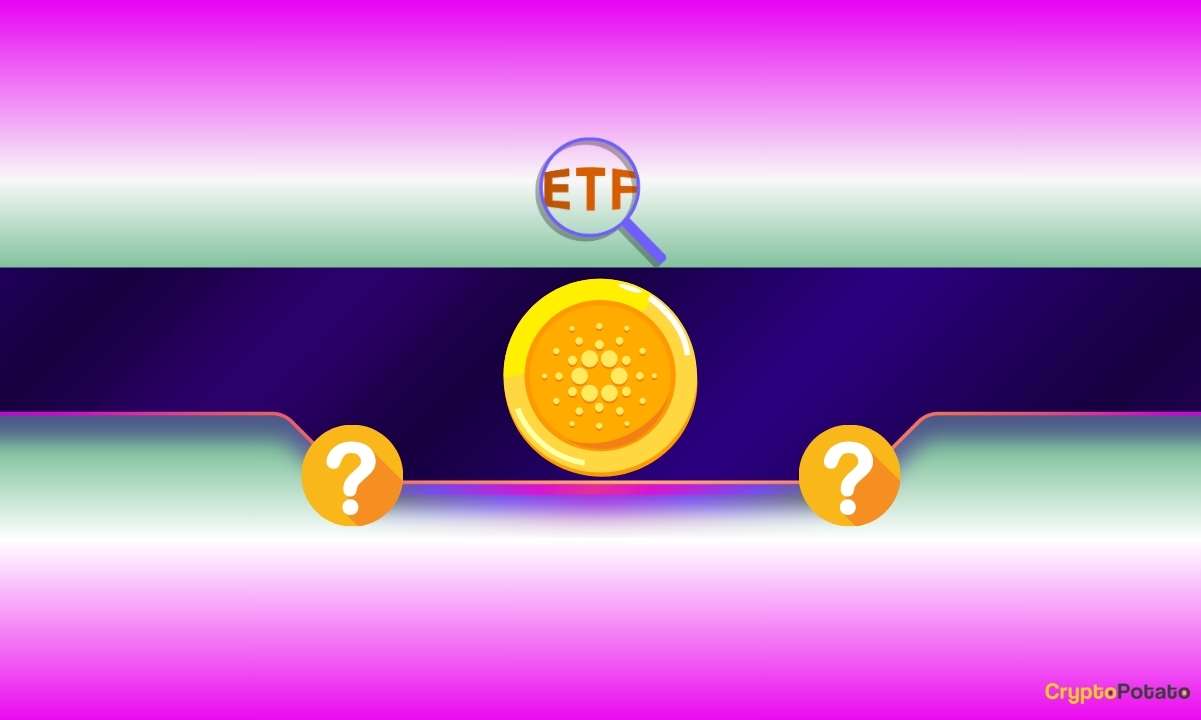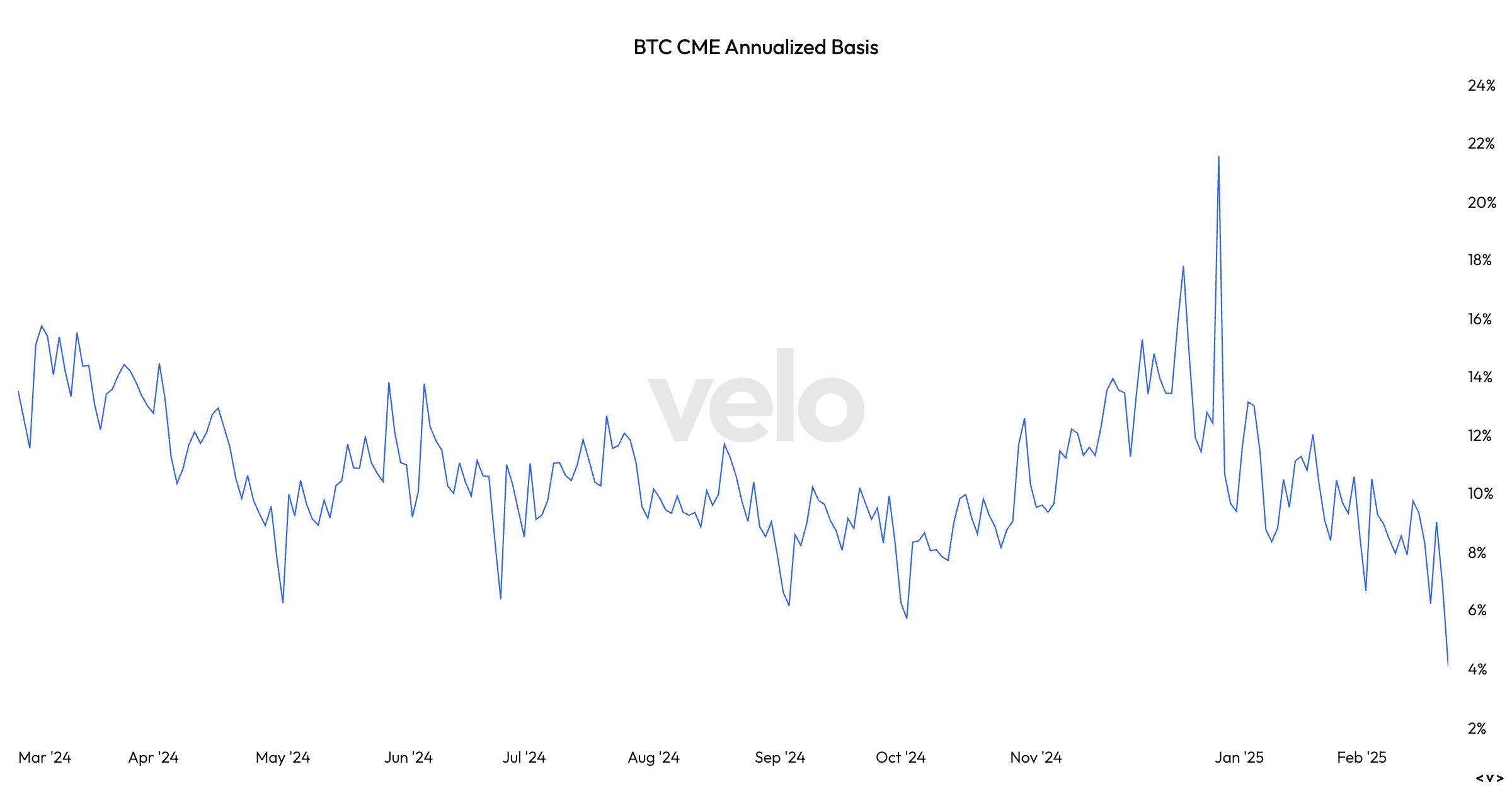
U.S. spot-listed bitcoin (BTC) exchange-traded funds (ETFs) experienced the second-biggest outflows of the year on Monday, dropping $516.4 million, Farside data shows. The withdrawals, the ninth net outflow in 10 days, reflect a growing discomfort with the largest cryptocurrency, which has traded in a narrow price range between $94,000 and $100,000 for most of this month. On Tuesday, bitcoin broke out of its three-month channel, falling below $90,000 and sliding to as low as $88,250 . According to Velo data, the bitcoin CME annualized basis — the difference between the spot price and futures — has dropped to 4%. This is the lowest since the ETFs started trading in January 2024. This is also known as the cash-and-carry trade, which is a market-neutral strategy that seeks to profit from the mispricing between the two markets. The strategy involves taking a long position in the spot market and a short position in the futures market. Velo data shows a one-month futures forward contract. Investors collect a premium between the spread of the spot and futures pricing until the futures contract expiry date closes. At the current level, the basis trade is less than the so-called risk-free rate, the yield on the U.S. 10-year Treasury of 5%. The difference may persuade investors to close their positions in favor of the greater return. That could see further outflows from the ETFs. Because this is a neutral strategy, investors will also have to close their short position in the futures market. Arthur Hayes , the co-founder of Bitmex, alludes to the basis trade unravelling in a post on X."Lots of IBIT holders are hedge funds that went long ETF short CME future to earn a yield greater than where they fund, short term US treasuries," he wrote. "If that basis drops as bitcoin falls, then these funds will sell IBIT and buy back CME futures. These funds are in profit, and given basis is close to UST yields they will unwind during US hours and realise their profit. $70,000 I see you mofo!"
CoinDesk
You can visit the page to read the article.
Source: CoinDesk
Disclaimer: The opinion expressed here is not investment advice – it is provided for informational purposes only. It does not necessarily reflect the opinion of BitMaden. Every investment and all trading involves risk, so you should always perform your own research prior to making decisions. We do not recommend investing money you cannot afford to lose.
Donald Trump’s crypto portfolio hits 12-month lows
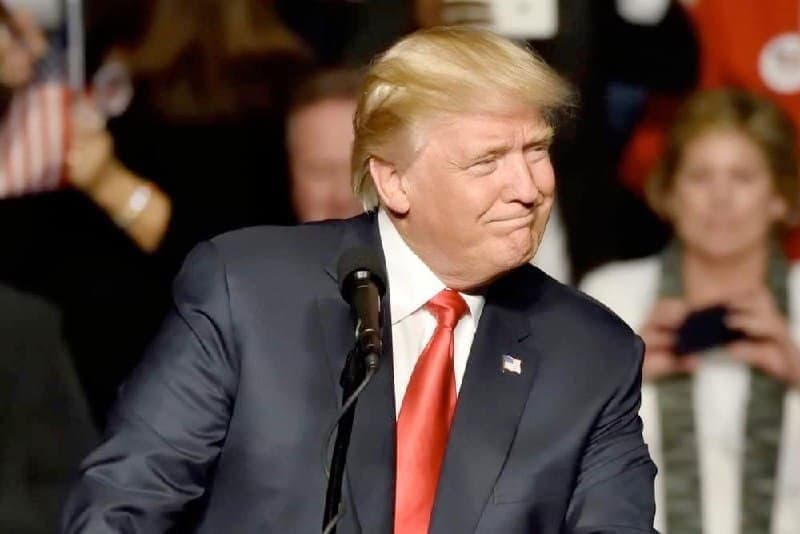
President Donald Trump has come a long way in his attitude toward cryptocurrency since he rejected Bitcoin ( BTC ) in his first term. Indeed, the billionaire politician has not only become rhetorically friendly but has actively been involved with digital assets, launching several non-fungible token ( NFT ) collections and even a set of family-themed inauguration meme coins . Simultaneously, however, Trump — or someone in his team — appears relatively keen to swapping cryptocurrency for regular currency as the President’s balance has been, per the data Finbold retrieved from Arkham Intelligence on February 25, shrinking rapidly. Donald Trump’s digital assets portfolio became particularly active during the election campaign due to numerous individuals or projects sending cryptocurrency to promote themselves or to help back the Republican. The activity ensured the associated address briefly ballooned to approximately $26 million in June 2024 and then, after a protracted period of remaining under $10 million, to a recent January 18 high near $23 million. Trump’s crypto portfolio falls 92% in just over a month In stark contrast to such figures, Donald Trump’s cryptocurrency balance, at press time on February 25, is a significantly lower $1.7 million. Donald Trump’s crypto portfolio on February 25. Source: Arkham Some of the $21.3 million decline can be attributed to the market fluctuations, particularly as, at press time, Bitcoin is trading below $89,000 for the first time since November, and Ethereum ( ETH ) below $2,400 for the first time since October. Still, Trump or his team has actively been selling, and the record clearly shows that the coin and token balance has decreased, not just their value in USD. A particularly interesting example of likely selling came in late January and early February when approximately 1,000 ETH were moved to hot wallets, only for Eric Trump to make an X post endorsing Ethereum . At press time, it is unclear if and when the cryptocurrency has been sold. The selling activity pertaining to Donald Trump’s cryptocurrency is interesting, both due to the speed of its execution and the rhetoric the President has adopted in recent months. Is Trump keeping his promises to the crypto community? The Republican has been a vocal supporter of the industry and the community, pledging to end what many believed to be the Biden administration’s war on crypto, to create a strategic Bitcoin reserve, and to ensure the U.S. is the global digital assets capital. Although Trump’s progress with regard to the industry and cryptocurrency has been slower than many had hoped, it has not been entirely lacking. As the President pledged, the U.S. government hasn’t sold any of its Bitcoin despite having a legal right to do so , per the data Finbold retrieved from Arkham on February 25. U.S. Government’s crypto portfolio on February 25. Source: Arkham Similarly, despite not forming a Bitcoin or other digital asset strategic reserve, Donald Trump issued an order for the relevant agencies to examine the feasibility and logistics of such a move quickly following his inauguration. The most recent development, however, might also be the most impactful yet as the Securities and Exchange Commission (SEC) has signaled it is dropping its lawsuit against the biggest publicly traded cryptocurrency exchange , Coinbase (NASDAQ: COIN ). Featured image via Shutterstock The post Donald Trump’s crypto portfolio hits 12-month lows appeared first on Finbold . CoinDesk
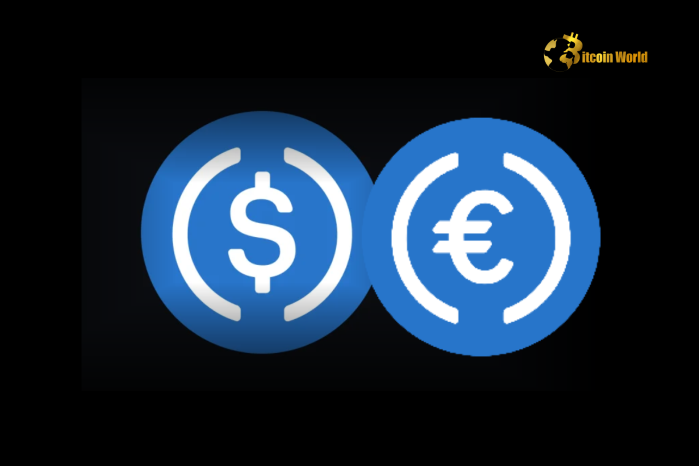
Groundbreaking DFSA Approval: USDC and EURC Revolutionize Dubai’s Crypto Landscape
In a significant leap for the cryptocurrency world, Dubai has solidified its position as a forward-thinking hub for digital assets. The Dubai Financial Services Authority (DFSA) has made waves by officially recognizing USDC and EURC as approved tokens within its regulatory framework. This exciting development, initially reported by Cointelegraph on X, marks a pivotal moment for stablecoin adoption and crypto innovation in the region. But what does this groundbreaking DFSA approval really mean for businesses and the future of finance in Dubai? What Does DFSA Approval of USDC and EURC Actually Mean? For those navigating the complex world of cryptocurrency regulations, clarity is paramount. The DFSA approval is not just a symbolic gesture; it’s a concrete regulatory green light. Here’s a breakdown of what this landmark decision entails: Official Recognition: USDC and EURC are now formally recognized by the DFSA as regulated tokens. This brings them under the purview of Dubai’s robust crypto regulatory framework, offering a level of legitimacy and security previously unavailable. Legitimate Use Cases: Companies operating within the Dubai International Financial Centre (DIFC) are now empowered to utilize USDC and EURC for a wide array of financial activities. These include: Payments: Streamlining transactions and enabling faster, more efficient payment systems. Treasury Management: Providing sophisticated tools for managing corporate finances in the digital age. Other Financial Purposes: Opening doors for innovative financial applications within the regulated ecosystem. First Stablecoins to Receive Status: USDC and EURC are trailblazers, becoming the first stablecoins to achieve this recognized token status from the DFSA. This sets a precedent for future stablecoin integrations and highlights Dubai’s proactive approach to embracing digital currencies. Why is Dubai’s Crypto Regulation Embracing Stablecoins Now? Dubai’s proactive stance on Dubai crypto regulation is no secret. The city has consistently positioned itself as a global leader in adopting innovative technologies, and cryptocurrency is no exception. But why are stablecoins, specifically USDC and EURC, gaining favor now? Stability and Reliability: Unlike volatile cryptocurrencies, stablecoins like USDC and EURC are pegged to fiat currencies (US Dollar and Euro respectively). This inherent stability makes them attractive for businesses seeking to utilize digital assets without the extreme price fluctuations associated with Bitcoin or Ethereum. Enhanced Business Efficiency: Stablecoins offer significant advantages for businesses, including: Faster Transactions: Crypto transactions are typically faster and more efficient than traditional banking systems, especially for international payments. Lower Fees: Reduced transaction costs compared to conventional financial intermediaries. Transparency and Traceability: Blockchain technology provides a transparent and auditable record of transactions. Attracting Global Crypto Businesses: By creating a clear and supportive regulatory environment for stablecoins, Dubai aims to attract more international crypto businesses and investment into the DIFC. Beyond USDC and EURC: What Other Cryptocurrencies Are DFSA Approved? While the spotlight is currently on USDC and EURC, it’s important to remember that the DFSA approval extends beyond just stablecoins. The regulator has already given the nod to a range of other cryptocurrencies, demonstrating a broad and inclusive approach to digital asset regulation. These approved cryptocurrencies include: Cryptocurrency Ticker Symbol Description Bitcoin BTC The original and most well-known cryptocurrency. Ethereum ETH A leading platform for decentralized applications and smart contracts. Litecoin LTC An early altcoin often referred to as the ‘silver to Bitcoin’s gold’. Toncoin TON Cryptocurrency associated with the Telegram Open Network. XRP XRP Designed for fast and low-cost international payments. ZetaChain ZETA A blockchain designed for omnichain interoperability. This diverse list showcases the DFSA’s commitment to fostering a comprehensive and dynamic crypto ecosystem within Dubai. Stablecoin Adoption: A Catalyst for Growth in DIFC Crypto? The stablecoin adoption in Dubai, spearheaded by the DFSA’s approval of USDC and EURC, is poised to be a significant catalyst for growth within the DIFC’s crypto sector. How will this impact the ecosystem? Increased Institutional Interest: Regulatory clarity around stablecoins can attract larger institutional investors who were previously hesitant due to regulatory uncertainties. Boost to Fintech Innovation: The ability to utilize stablecoins for payments and treasury management will fuel innovation in fintech applications within the DIFC. Enhanced Competitiveness: Dubai’s proactive approach to stablecoin regulation strengthens its position as a globally competitive hub for digital assets, attracting businesses and talent from around the world. Wider Crypto Ecosystem Growth: As stablecoins become more integrated into the financial system, it can contribute to the overall growth and maturity of the broader cryptocurrency ecosystem. Navigating the Future of DIFC Crypto with Stablecoins The DIFC crypto landscape is rapidly evolving, and the DFSA’s approval of USDC and EURC marks a significant step forward. While this development presents exciting opportunities, it’s crucial to consider both the benefits and potential challenges: Benefits: Regulatory Certainty: Provides a clear and regulated framework for stablecoin use. Business Efficiency: Enhances transaction speeds and reduces costs for businesses. Innovation Hub: Positions Dubai as a leading center for crypto innovation and adoption. Global Attractiveness: Attracts international crypto businesses and investment. Considerations: Ongoing Regulatory Evolution: The crypto regulatory landscape is still evolving globally, and businesses need to stay updated with any future changes. Compliance Requirements: Operating within the DFSA framework requires adherence to specific compliance standards. Market Volatility (Broader Crypto Market): While stablecoins are pegged to fiat, the broader crypto market can still experience volatility that may indirectly impact businesses. Conclusion: Dubai’s Bold Move into the Stablecoin Era The DFSA’s landmark approval of USDC and EURC is more than just a regulatory update; it’s a powerful statement of intent from Dubai. By embracing stablecoins within a clear and robust framework, Dubai is not only fostering innovation within the DIFC but also solidifying its place at the forefront of the global crypto revolution. This bold move is set to unlock new opportunities for businesses, attract further investment, and pave the way for a more efficient and inclusive financial future. The ripple effects of this revolutionary decision are likely to be felt across the global crypto landscape for years to come, inspiring other jurisdictions to consider the transformative potential of stablecoin adoption. To learn more about the latest crypto market trends, explore our article on key developments shaping Bitcoin institutional adoption. CoinDesk

